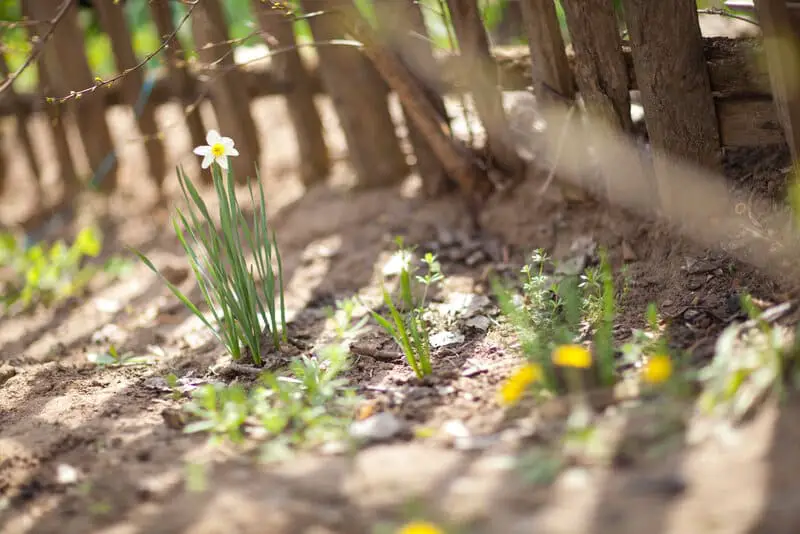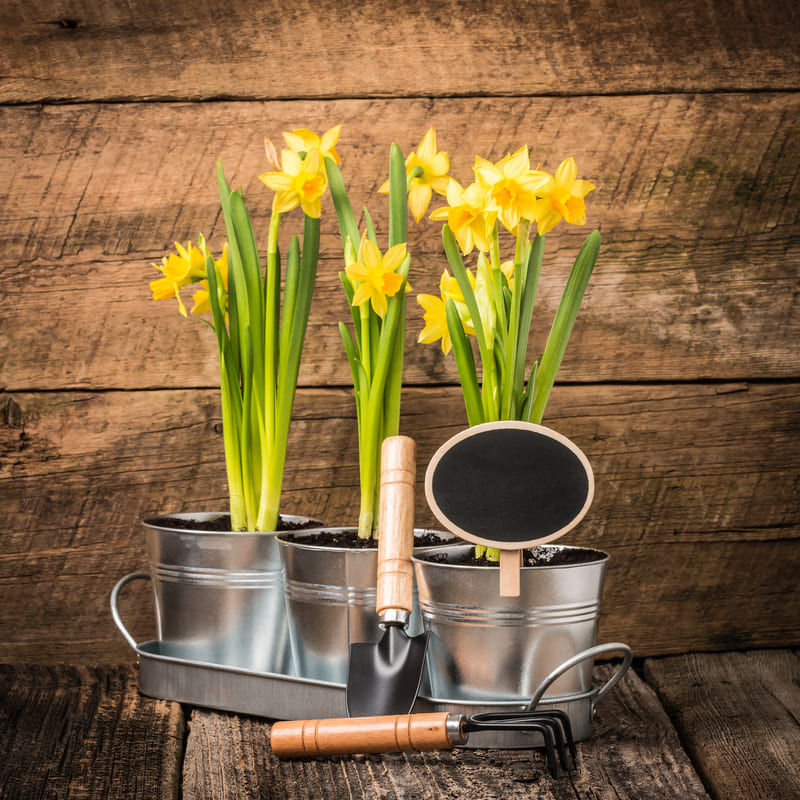This magical herald of spring in the northern hemisphere, Daffodil or Narcissus in Latin, belongs to the bulb plant genus in the Amaryllidaceae family.
It blooms from February to March and sometimes until mid-April. The plant has narrow, oblong, and soft leaves of light green color which form the clump.
The stem is hollow and generally has only one flower. The flower consists of six petals and a trumpet-shaped crown. The standard colors of the flowers are white, yellow, and orange, with a coronet of the same or different color.
Always popular and almost classic decoration of the spring garden, narcissus is a modest and durable plant, effortlessly grown from daffodil bulbs.
What is the best month to plant daffodil bulbs?
Daffodil bulbs are best planted in the fall to bloom in early spring. Depending on the overall weather conditions, it is best to plant them in the first half of October.
In other words, if you want abundant flowering in the spring, then plant the bulbs for at least two to four weeks before the soil feeze in the fall.
Or, more precisely, plant the bulbs in soil whose temperature is between 46 and 50 F degrees. At this soil temperature, the bulbs have ideal conditions to take root before the soil around them freezes.
In addition, autumn is a season rich in precipitation that softens the groung and provides the moisture necessary for root development.
How to plant daffodil?
Daffodils are often planted in combination with tulips and hyacinths, and due to the content of certain substances, they repel voles and mice, as well as deer, squirrels, and rabbits.
Thanks to this feature, daffodils have long been planted to guard houses and warehouses.
When planting bulbs, always choose those that have no visible damage and signs of rot. Also, take the larger ones as they will give larger flowers. Plant them at a depth that is twice the size of the bulb.
The depth of planting bulbs can affect the onset of flowering. The bulbs you planted shallower will start growing vegetation earlier in the spring while the deeper planted bulbs bloom later.
However, never plant them too shallow because the layer of soil that ensures that they do not freeze during the winter must be at least 4 inches thick.
Plant the bulbs individualy at a distance of 3 to 4 inches, and cover them with a loose layer of soil. If there is not enough rainfall, water them to take root and be ready for winter.
Over the winter, you can cover with hay, straw, dry leaves, sawdust, or spruce branches to protect them from freezing.
Spring planting
If you failed to plant the bulbs in the fall, you could do so in the spring as soon as the soil thaws enough that you can dig.
However, you have to keep in mind that the bulbs planted in the spring, even if they start with vegetation, might not bloom in that season.
Spring is a deceptive season with many temperature oscillations that can negatively affect root formation and plant growth.
Another salient thing that conditions the flowering of daffodils planted in the spring is the overwintering storage of the bulbs.
Those that have wintered in a cold and dark place are more likely to develop enough to bloom before temperatures become too high.
Do daffodils come back every year?
Daffodils are perennials that can spend the winter outside and bloom again next spring. Unlike dahlias, for example, frozen soil will not harm them.
These are hardy and reliable plants that will grow in the garden for the next 4 to 5 years once you plant them.
However, from year to year, the flowers will become smaller, and it is possible that in the end, you only have a leaf mass without flowers! The reason is that new and old bulbs grow together, and daffodil bulbs like to be separated from each other!
Do daffodils multiply?
Each bulb you plant in the fall will develop 4 to 7 new small bulbs. If you leave them in the ground altogether, the new bulbs will not have enough space to grow properly.
Additionally, the new bulbs will bother and press the central bulb. In such circumstances, surrounded by tightly adorned offspring, the mother bulb will bloom less and less.
Therefore, if you want your daffodils to retain a bunch of large flowers in late spring when their leaves wither, take them out of the ground.
Separate the bulbs, choose only the larger ones and store until autumn in a cold and dark place like a basement or pantry. The temperature in the room where you store the bulbs should not be above 62 F.
If you leave them in the ground, it would still be good to dig up the bulbs at least every other year, inspect them for damage, separate and bury them in the ground again.
How do you encourage daffodils to spread?
A common mistake when growing daffodils is to prune the leaves immediately after flowering is over.
Therefore, newly formed bulbs remain small and underdeveloped, and the central bulbs fail to store enough nutrients for abundant flowering the following spring.
Instead of cutting, leave the clumps until the leaves start to dry. It is a sign that one life cycle is naturally over and that the plant enters the dormant phase with increasing temperature.
It is the only way to ensure that you get a few bulbs developed and large enough to give flowers in the spring.
Potted Daffodil?
Although traditionally grown on flower beds, daffodils can also be grown in pots. If you opt for such cultivation, pay attention to the following :
- Take a pot with drainage holes, that is least 15 inches deep, and just as wide. 1.
- Fill the bowl with the nutrient substrate up to two-thirds.
- Lay the bulbs with the top facing up in the circle two inches from the edge of the pot and with the same amount of space between them.
- Cover the bulbs with a layer of substrate two to three inches thick. If you plant the bulbs in the fall, it would be a good idea to wrap the pot with a cloth or line it with styrofoam to prevent it from freezing completely.
- Keep the pot in a sheltered place in the garden. You can place it next to a wall or under the roof until the leaves appear.
- When the leaves appear, remove the pot to a sunny position.
Tips for growing daffodil
The best places to grow daffodils should be sheltered from the wind and have a slight slope because daffodils do not tolerate too moist soil.
Narcissus needs a balanced diet of mineral elements for growth and flowering. It uses a lot of potassium and phosphorus to form bulbs and bloom.
Therefore, do not plant next to fast-growing plants because they will take away water and nutrients, and the daffodil will lag in growth and flower formation.
Daffodils need a lot of sunlight to bloom. Therefore, don’t plant them in shaded beds! They will bloom more abundantly if they are exposed to direct sunlight for at least half a day!
Daffodils prefer soils with a pH-neutral or slightly acidic reaction, which are loose, nutritious, and well permeable.
If the soil in your garden is clayey, before planting the bulbs, dig it at least 15 inches deep, and add a little sand or humus to improve its quality. In compacted and poorly drained soils, daffodil bulbs can rot.
Do not use manure on the soil in which you want to plant daffodils. It can be infected with the rot-causing Erwinia bacterium.
When the plants get sick, the only remedy is to pull them all up and throw them away, and don’t plant bulbs in that place for the next three years.


